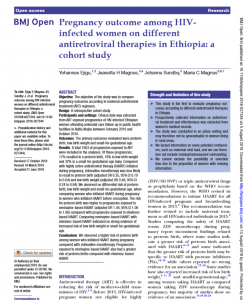
Objective
The objective of the study was to compare pregnancy outcomes according to maternal antiretroviral treatment (ART) regimens.
Design
A retrospective cohort study.
Participants and settings
Clinical data was extracted from ART exposed pregnancies of HIV-infected Ethiopian women attending antenatal care follow-up in public health facilities in Addis Ababa between February 2010 and October 2016.
Outcomes
The primary outcomes evaluated were preterm birth, low birth weight and small-for-gestational-age.
Results
A total 1663 of pregnancies exposed to ART were included in the analyses. Of these pregnancies, 17% resulted in a preterm birth, 19% in low birth weight and 32% in a small-for-gestational-age baby. Compared with highly active antiretroviral therapy (HAART) initiated during pregnancy, zidovudine monotherapy was less likely to result in preterm birth (adjusted OR 0.35, 95% CI 0.19 to 0.64) and low birth weight (adjusted OR 0.48, 95% CI 0.24 to 0.94). We observed no differential risk of preterm birth, low birth weight and small-for-gestational-age, when comparing women who initiated HAART during pregnancy to women who initiated HAART before conception. The risk for preterm birth was higher in pregnancies exposed to nevirapine-based HAART (adjusted OR 1.44, 95% CI 1.06 to 1.96) compared with pregnancies exposed to efavirenz-based HAART. Comparing nevirapine-based HAART with efavirenz-based HAART indicated no strong evidence of increased risk of low birth weight or small-for-gestational-age.
Conclusions
We observed a higher risk of preterm birth among women who initiated HAART during pregnancy compared with zidovudine monotherapy. Pregnancies exposed to nevirapine-based HAART also had a greater risk of preterm births compared with efavirenz-based HAART.